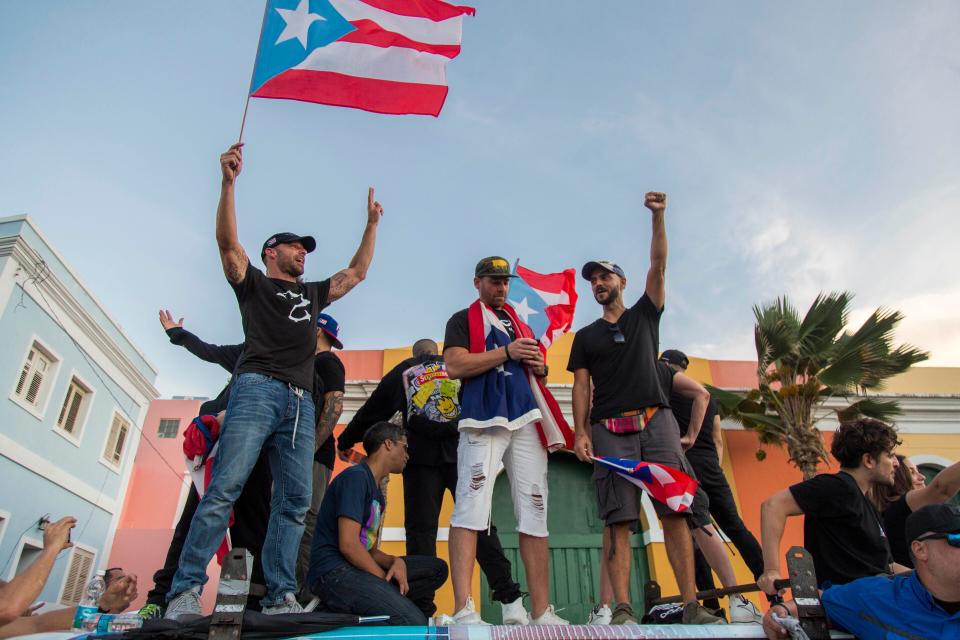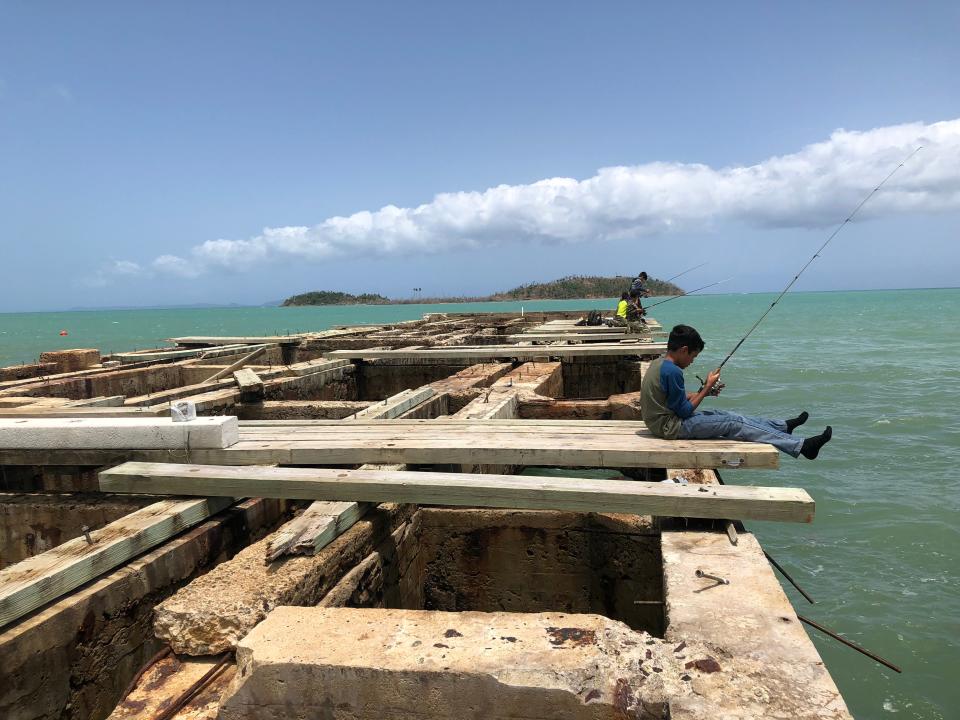2 years after hurricanes, Trump administration has OK'd only 9 projects for funding in Puerto Rico
WASHINGTON – Nearly two years after Hurricanes Irma and Maria left Puerto Rico in shambles, the pace of recovery on the U.S. territory remains at a crawl as the island faces fresh controversies and verbal attacks from President Donald Trump.
Disputes between the Trump administration and island leaders over rebuilding costs and the unsteady implementation of a new process to approve project funding have severely hamstrung recovery.
Out of some 10,000 schools, bridges and other damaged sites dotting the island, funding for only nine have gotten the green light from the Federal Emergency Management Agency (FEMA) as of Wednesday.
And new crises could imperil the island's already hobbled recovery process even further.

Puerto Rico Gov. Ricardo Rosselló faces calls to resign over two separate scandals: a fraudulent scheme involving federal funds that ensnared two former top aides; and the release of private chat messages between the governor and other top aides that were insulting and inflammatory.
The "chatgate" scandal, as it's been dubbed, sparked large protests in San Juan on Wednesday night and prompted Puerto Rican celebrities such as singer Ricky Martin and "Hamilton" creator Lin-Manuel Miranda to demand Rosselló's ouster.
Trump, whose running feud with Puerto Rican officials contributed to the delay of more than $1 billion in disaster aid this past spring, is taking more shots at Puerto Rico's leaders. On Thursday, he once again berated them on Twitter, accusing them of being corrupt, squandering hurricane recovery money and "robbing the U.S. government blind."
....of which was squandered away or wasted, never to be seen again. This is more than twice the amount given to Texas & Florida combined. I know the people of Puerto Rico well, and they are great. But much of their leadership is corrupt, & robbing the U.S. Government blind!
— Donald J. Trump (@realDonaldTrump) July 18, 2019
It's not clear whether such scandals, while drawing Trump's attention, could affect the drawn-out process that has stalled projects intended to reinvigorate life in Puerto Rico.
Congress has approved about $42 billion for Puerto Rico recovery since 2017, when Irma and Maria unleashed on the island, including some $21 billion to begin repair or reconstruction of thousands of permanent projects such as schools, bridges, government facilities and utility infrastructure destroyed from the devastating storms.
So far, the nine projects the Trump administration has OK'd total about $13.3 million, according to Puerto Rico's Central Office for Recovery, Reconstruction, and Resilience. That total does not include billions FEMA has granted for hundreds of emergency repair pro that are not part of the permanent recovery effort.
An ongoing dispute between the Federal Emergency Management Agency and island officials over how to determine cost estimates has slowed the process, according to a government watchdog.
Cruises canceled: Royal Caribbean cancels Puerto Rico cruise stop amid protests
Trump's feud: Disaster aid passes Congress after months of delays over costs, border wall and Trump's feud with Puerto Rico
FEMA's implementation of a new funding approval process, adopted by Congress following Hurricane Sandy in 2012, is being used on a wide scale for the first time and is complicating efforts, said Chris Currie, director of Homeland Security and Justice for the U.S. Government Accountability Office.
“The recovery so far has been slow and very challenging. And challenging at all levels of government,” he said during a House Homeland Security subcommittee meeting July 11. “There are thousands of potential projects … There’s a long way to go in this area.”
And things could get worse.
If Puerto Rico does not meet an Oct. 11 deadline to finalize fixed-cost estimates for projects, the pace of approvals — which have slowly been ramping up — could slow to a trickle, island officials warn.
“Even now, nearly two years after, over 300,00 children attend schools which have not been repaired,” Omar J. Marrero, who heads the island's recovery efforts. “And many of them have to still go to homes with (FEMA’s) blue-tarp roofs. It has been life changing for everyone on the island.”

In addition to the projects, nearly $13 billion has been disbursed to the island for emergency work, such as debris removal and electricity restoration, and for direct food and shelter assistance, according to Puerto Rico officials.
The nine permanent projects moving forward include two apartment complexes, a communications tower and an arts school, they said.
Another 38 projects have gotten the go-ahead but no work has started. In addition, 125 projects have been submitted to FEMA, but are waiting a final sign-off that in some case has taken months.
Marrero told USA TODAY his agency has drawn up estimates on about 2,000 other projects that are still in negotiation. And several thousand more sites have been visited but lack an official estimate.
Estimates for project work are key under the new model that Congress approved in 2013 after Hurricane Sandy struck the Northeast.
Designed to promote more efficient project delivery, it allows local governments to keep any surplus below the estimate and use it on another site. But if the project comes in above budget, the government is solely responsible for covering the overrun.
“We are facing an enormous risk when we decide if we agree or do not agree (on an estimate)," Marrero said. Because "that’s all you get."
Statehood status: Puerto Rico: At the center of a political storm, but can its residents vote for president?
Fuel aid denied: Donald Trump says he won't grant shipping waivers that could send more fuel to Puerto Rico
That's led to lengthy negotiations over project estimates which in turn has complicated recovery efforts because FEMA can't release construction money until those estimates are agreed to by all parties.
In the past, work could begin sooner and negotiations over unforeseen costs were often handled during or after construction was complete but flexibility over what could be rebuilt was limited, he said.
A FEMA spokesperson said the agency has made "significant collaborative efforts" to work with Marrero's office to develop estimation models but said Puerto Rico's "lack of resource capacity has slowed the ability to reach fixed cost estimates" – a characterization Marrero disputes.
The agency also is defending its review process, saying it wants to make sure tax dollars are spent well.
"The impact and challenges of (the hurricanes) is unprecedented," the agency spokesperson said. "The intent of quality control and quality assurance is to verify that obligated grants are eligible. Processing insufficiently documented work or ineligible grants are not appropriate and do a disservice to the applicants as it could result in having funds de-obligated."
Puerto Rico was already facing herculean recovery challenges due to the island-wide devastation from both hurricanes and its political status as a territory means it doesn't get some of the same federal rebuilding benefits a state does following a natural disaster, experts said.
Marrero said the Trump administration has contributed to delays by not treating Puerto Rico "fairly" by implementing bureaucratic hurdles and by refusing to recognize estimates developed by engineers licensed by the territory.
"We were required to establish centralized oversight authority. We did it. We were required to hire third party experts. We did it. We were required to integrate technology and ensure that we had controls, policies and procedures. We did it in collaboration in FEMA," Marrero said. "We went the extra mile.
This article originally appeared on USA TODAY: Trump tweets as Puerto Rico's Irma, Maria hurricane recovery trickles

